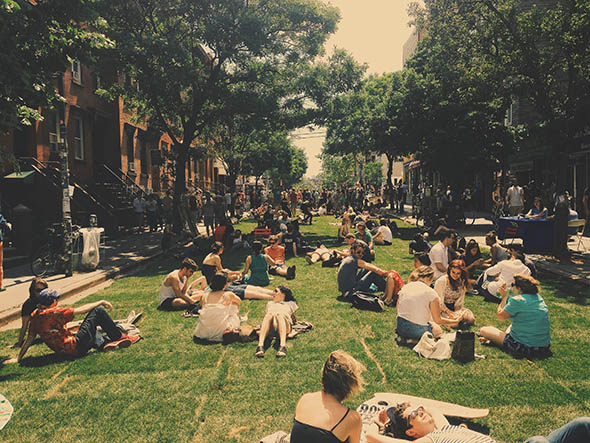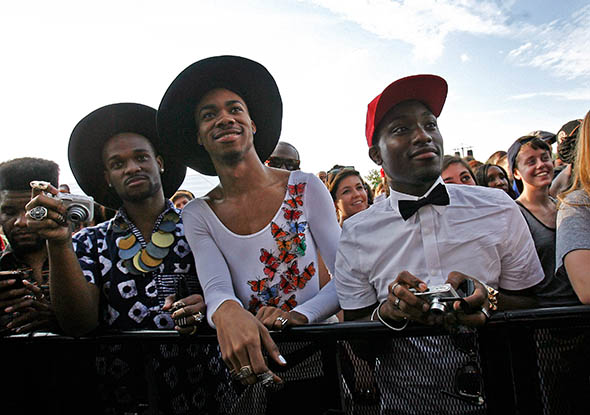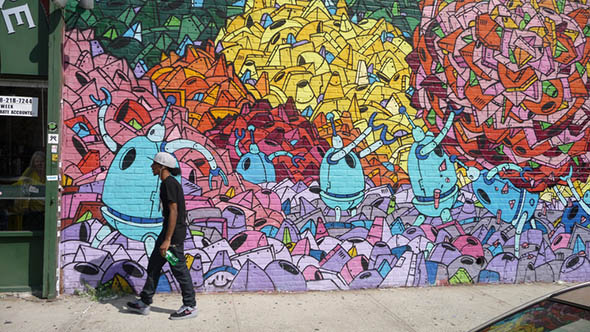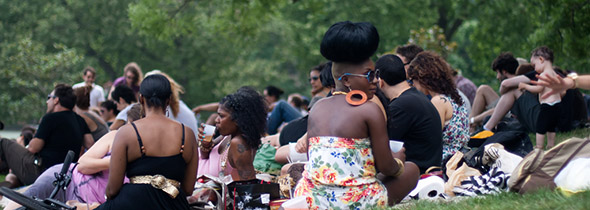The Myth of Gentrification
It’s extremely rare and not as bad for the poor as you think.
By John Buntin

A summer festival in June 2014 in Williamsburg, Brooklyn.
Photo by Jens Karlsson/Getty Image
It’s extremely rare and not as bad for the poor as you think.
By John Buntin

A summer festival in June 2014 in Williamsburg, Brooklyn.
Photo by Jens Karlsson/Getty Image
@The RealIt started in Soho, then moved to Chelsea and the East Village. Riots in Tompkins Square in 1988 earned it some headlines but didn’t stop its creeping advance. It moved on to lower Harlem, then jumped the river to Park Slope. Williamsburg and Fort Greene followed; today, it threatens even Bedford-Stuyvesant. New York isn’t the only city where it spreads. San Francisco, Washington, and Boston have arguably been even more affected by it. Seattle, Atlanta, and Chicago have experienced it on a large scale, too.
The “it,” as you may have guessed, is gentrification. If you live in one of these cities, you probably think you know how it works. Artists, bohemians, and gay couples come first. They move into run-down—but charming and historic—homes and loft spaces close to the urban core. Houses are restored. Funky coffee shops appear. Public safety improves. Then rents and home prices start to go up. The open-minded, diversity-loving creative types who were the first wave of gentrifiers give way to lawyers, bankers, and techies. As rents and home prices continue to rise, the earlier residents—often lower-income people of color—are forced out.
That’s the story, at least. Read the Atlantic’s City Lab, and you regularly encounter titles such as “Why Gentrification Is So Hard to Stop” and “There’s Basically No Way Not to Be a Gentrifier.” Liberals and conservatives alike agree that it is bad (although liberals blame developers, and conservatives blame onerous regulations that limit development). Even Jezebel has joined in. It recently chided Taylor Swift (who earlier this year traded her comparatively affordable $2 million apartment in Nashville for a $20 million penthouse in Tribeca) for including an “obtuse” “gentrification anthem” in her latest album.
That gentrification displaces poor people of color by well-off white people is a claim so commonplace that most people accept it as a widespread fact of urban life. It’s not. Gentrification of this sort is actually exceedingly rare. The socio-economic status of most neighborhoods is strikingly stable over time. When the ethnic compositions of low-income black neighborhoods do change, it’s typically because Latinos and other immigrants move into a neighborhood—and such in-migration is probably more beneficial than harmful. As for displacement—the most objectionable feature of gentrification—there’s actually very little evidence it happens. In fact, so-called gentrifying neighborhoods appear to experience less displacement than nongentrifying neighborhoods.
It’s time to retire the term gentrification altogether. Fourteen years ago, Maureen Kennedy and Paul Leonard of the Brookings Institution wrote that gentrification “is a politically loaded concept that generally has not been useful in resolving growth and community change debates because its meaning is unclear.” That’s even truer today. Some U.S. cities do have serious affordability problems, but they’re not the problems critics of gentrification think they are. Worse, the media focus on gentrification has obscured problems that actually are serious: the increasing isolation of poor, minority neighborhoods and the startling spread of extreme poverty.
* * *
Gentrification, as it is commonly understood, is about more than rising housing prices. It’s about neighborhoods changing from lower-income, predominantly black or Latino neighborhoods to high-income, predominantly white neighborhoods. Demographers and sociologists have identified neighborhoods where this kind of displacement has occurred. Wicker Park in Chicago, Harlem and Chelsea in Manhattan, Williamsburg in Brooklyn—these places really did gentrify. Sociologists and demographers captured these changes in case studies and ethnographies. But starting a decade ago, economists began to ask more nuanced questions about the displacement the other social sciences were documenting. Simply documenting that low-income people were being forced out of a neighborhood whose housing prices were rising didn’t mean in and of itself that gentrification was causing displacement, they noted. Poor people often move away from nongentrifying neighborhoods, too. Indeed, low-income people move frequently for a variety of reasons. The real question was whether low-income residents moved away from “gentrifying” neighborhoods at a higher rate than they did from nongentrifying neighborhoods.

Fans watch as Solange performs during the Northside Festival at McCarren Park on June 16, 2013, in Brooklyn.
Photo by Mike Lawrie/Getty Images






 . I used to highlight shyt, but that's a lot of work. It's obvious cats like
. I used to highlight shyt, but that's a lot of work. It's obvious cats like